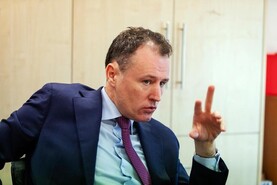On pages 38-39 Martin Merrick details the cost of a typical cattle shed we profiled four years ago if the same shed were to be constructed in 2022.
For a young farmer claiming the 60% grant, the net cost has increased by over 70%.
It is no surprise given the rise in the price of steel and concrete that the investment in farm buildings is showing real signs of cooling off.
These on-farm investments often have a positive effect on the environment and labour efficiency, especially on part-time farms. If they don’t continue, the reality is farm sustainability will take a back seat.
The Department urgently needs to revisit the TAMS grant aid estimates or investment in slurry storage and farm buildings looks like it will grind to a halt.

Cost concerns balanced by positive trends in farmer attitudes
The ifac survey gives a good insight into what farmers are thinking across the different sectors of Irish farming.
While 2021 was a year of improving prices, the survey highlights the concern of farmers about soaring costs in 2022 across all sectors. This is combined with increasing concerns about farming impact on lifestyles, with up to a third of beef farmers struggling to combine farming with off farm work.
While there are concerns, there are positives in the survey. Perhaps the most striking is that a massive 94% of all respondents recognised the importance of reducing greenhouse gases on farms. This commitment to achieve more on top of what is one of the most efficient farming systems in the world should be noted by policymakers as final targets for emission reduction targets are being prepared.
Managing the carbon cycle with cattle
On pages 16 and 17, Amy Forde highlights some of the innovation in action on the hills of Donegal.
In contrast to the politically popular destocking tune, instead they are restocking the Inishowen peninsula with cattle in order to better manage the carbon cycle and create an environment that is beneficial for everybody.
The benefits or the outcomes of these projects are much more long-term in nature and a three- or five-year project will really only set the project up – they must be more longer-term initiatives.
On pages 38-39 Martin Merrick details the cost of a typical cattle shed we profiled four years ago if the same shed were to be constructed in 2022.
For a young farmer claiming the 60% grant, the net cost has increased by over 70%.
It is no surprise given the rise in the price of steel and concrete that the investment in farm buildings is showing real signs of cooling off.
These on-farm investments often have a positive effect on the environment and labour efficiency, especially on part-time farms. If they don’t continue, the reality is farm sustainability will take a back seat.
The Department urgently needs to revisit the TAMS grant aid estimates or investment in slurry storage and farm buildings looks like it will grind to a halt.

Cost concerns balanced by positive trends in farmer attitudes
The ifac survey gives a good insight into what farmers are thinking across the different sectors of Irish farming.
While 2021 was a year of improving prices, the survey highlights the concern of farmers about soaring costs in 2022 across all sectors. This is combined with increasing concerns about farming impact on lifestyles, with up to a third of beef farmers struggling to combine farming with off farm work.
While there are concerns, there are positives in the survey. Perhaps the most striking is that a massive 94% of all respondents recognised the importance of reducing greenhouse gases on farms. This commitment to achieve more on top of what is one of the most efficient farming systems in the world should be noted by policymakers as final targets for emission reduction targets are being prepared.
Managing the carbon cycle with cattle
On pages 16 and 17, Amy Forde highlights some of the innovation in action on the hills of Donegal.
In contrast to the politically popular destocking tune, instead they are restocking the Inishowen peninsula with cattle in order to better manage the carbon cycle and create an environment that is beneficial for everybody.
The benefits or the outcomes of these projects are much more long-term in nature and a three- or five-year project will really only set the project up – they must be more longer-term initiatives.







 This is a subscriber-only article
This is a subscriber-only article










SHARING OPTIONS: